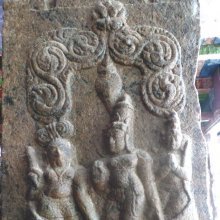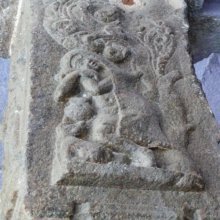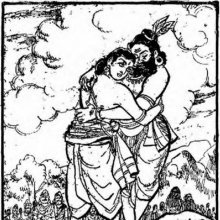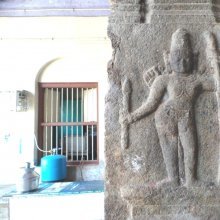Guha, Guhā, Gūhā: 39 definitions
Introduction:
Guha means something in Buddhism, Pali, Hinduism, Sanskrit, Jainism, Prakrit, the history of ancient India, Marathi, Hindi, biology. If you want to know the exact meaning, history, etymology or English translation of this term then check out the descriptions on this page. Add your comment or reference to a book if you want to contribute to this summary article.
Images (photo gallery)
(+5 more images available)
In Hinduism
Shilpashastra (iconography)
Source: Wisdom Library: Elements of Hindu IconograpyGuha (additional aspect of Subrahmaṇya, according to the Śrītatvanidhi) should have one face, three eyes and four arms. His head should be adorned with a kirīṭa made of gold set with rubies. In the right hands there should be the vajra and the śula and the left hands should be held in the varada and the abhaya poses. His Devī should be by his side and they should look like a newly married couple.

Shilpashastra (शिल्पशास्त्र, śilpaśāstra) represents the ancient Indian science (shastra) of creative arts (shilpa) such as sculpture, iconography and painting. Closely related to Vastushastra (architecture), they often share the same literature.
Purana and Itihasa (epic history)
Source: archive.org: Puranic Encyclopedia1) Guha (गुह).—King of the country of Niṣādas alias Śṛṅgiverapura, on the banks of the river Gaṅgā. Śrī Rāma when he went on exile to the forests went to the residence of Guha accompanied by Lakṣmaṇa and Sītā. Guha, a devotee of Rāma, received them with respect offering them many kinds of fruits and roots to eat. But Śrī Rāma said that it was not proper to accept fruits and roots and so he drank only pure water from him. But Guha was asked to feed his horse. At night when Lakṣmaṇa stood watch over Rāma and Sītā, Guha volunteered to stand guard but Lakṣmaṇa refused to accept the offer. So Guha kept company with Lakṣmaṇa and both of them spent the night talking to each other. In the morning as per Rāma’s request Guha brought a canoe and Guha himself took Rāma, Lakṣmaṇa and Sītā to the other side of the river. (Sarga 50, Vālmīki Rāṃāyaṇa, Ayodhyā Kāṇḍa).
Guha is seen next when Bharata comes to the forest in search of Rāma. When Bharata returned from Kekaya he went in search of Śrī Rāma and Lakṣmaṇa and came to Guha in Śṛṅgiverapura. Guha then gave Bharata all available information regarding Śrī Rāma. Guha then sent the Dāśa army along with Bharata. (Sarga 84, Ayodhyā Kāṇḍa, Vālmīki Rāmāyaṇa).
Guha, chief of Śṛṅgiverapura, spent the night with Rāma and Lakṣmaṇa under an Oka tree. (Chapter 6, Agni Purāṇa).
2) Guha (गुह).—A tribe of people of ancient India. Āndhras, Pulindas, Cucukas, Guhas, Śabaras and Bhadras are some of the tribes of the south. (Śloka 42, Chapter 207, Śānti Parva).
Source: Cologne Digital Sanskrit Dictionaries: The Purana Index1a) Guha (गुह).—(God Subrahmaṇya, Senāpati) a son of Ambikā (Pārvati) was born as Sāmba, son of Kṛṣṇa. Tīrtha sacred to, in the Sarasvatī visited by Vidura.1 Guha is said to hve shot arrows at Krauñca hill.2 Fought with Tāraka in the Devāsura war and with Pradyumna at Śonitapura.3 Relieved Mucukunda defending Heaven.4 With peacock as riding animal, defended Tripurāri's chariot; birth of, in a Śaravana, as a baby of seven days killed Asura Tāraka.5 Weapon Śakti.6
- 1) Bhāgavata-purāṇa III. 1. 22. and 30. Brahmāṇḍa-purāṇa III. 24. 4; IV. 30. 104; Vāyu-purāṇa 30. 315; 39. 55, 41. 40; Viṣṇu-purāṇa V. 33. 26.
- 2) Bhāgavata-purāṇa V. 20. 19.
- 3) Ib. VIII. 10. 28; X. 63. 7.
- 4) Ib. 51. 16.
- 5) Matsya-purāṇa 133. 64; 140. 40; 146. 10-11; 266. 42.
- 6) Viṣṇu-purāṇa III. 2. 12.
1b) The ruler of kingdoms Kalinga, Mahiṣa, Mahendranilaya, etc.*
- * Brahmāṇḍa-purāṇa III. 74. 198; Vāyu-purāṇa 99. 386.
1c) Rule over Kalinga, Māhiṣa, and Mahendra hill regions.*
- * Viṣṇu-purāṇa IV. 24. 65.
2) Guhā (गुहा).—Cave (golden) in Kuhariṇi in Meru where Vyāsa composed the four Vedas having conquered hunger, mind and āsana; after one hundred years of contemplation the Vedas came to him in their full form.*
- * Vāyu-purāṇa 104. 67-9.
Guha (गुह) is a name mentioned in the Mahābhārata (cf. ) and represents one of the many proper names used for people and places. Note: The Mahābhārata (mentioning Guha) is a Sanskrit epic poem consisting of 100,000 ślokas (metrical verses) and is over 2000 years old.
Source: academia.edu: La maternité adoptive de la déesse dans le SkandapurāṇaGuhā (गुहा) refers to a “ravine”, according to Kalhaṇa’s Rājataraṅgiṇī verse 1.29.—Accordingly, “There Gaurī, though she has assumed the form of the Vitastā, still keeps her wonted inclination. [For in her river-shape] she turns her face towards the ravine (guhā), just as [in her godlike form] she turns it towards [her son] Kumara (guha); [in her river-shape] the mouths of the Nāgas drink her abundant water, just as [in her godlike form her] elephant-faced [son Gaṇeśa], drank her abundant milk”.

The Purana (पुराण, purāṇas) refers to Sanskrit literature preserving ancient India’s vast cultural history, including historical legends, religious ceremonies, various arts and sciences. The eighteen mahapuranas total over 400,000 shlokas (metrical couplets) and date to at least several centuries BCE.
Natyashastra (theatrics and dramaturgy)
Source: Wisdom Library: Nāṭya-śāstraGuha (गुह) is the Sanskrit name for a deity to be worshipped during raṅgapūjā, according to the Nāṭyaśāstra 3.1-8. Accordingly, the master of the dramatic art who has been initiated for the purpose shall consecrate the playhouse after he has made obeisance (e.g., to Guha).

Natyashastra (नाट्यशास्त्र, nāṭyaśāstra) refers to both the ancient Indian tradition (shastra) of performing arts, (natya—theatrics, drama, dance, music), as well as the name of a Sanskrit work dealing with these subjects. It also teaches the rules for composing Dramatic plays (nataka), construction and performance of Theater, and Poetic works (kavya).
Shaktism (Shakta philosophy)
Source: Wisdom Library: ŚāktismGuha (गुह) refers to one of the 53 gods to be worshipped and given pāyasa (rice boiled in milk) according to the Vāstuyāga rite in Śaktism (cf. Śāradātilaka-tantra III-V). The worship of these 53 gods happens after assigning them to one of the 64 compartment while constructing a Balimaṇḍapa. Vāstu is the name of a prodigious demon, who was killed by 53 gods (e.g., Guha).
Source: Google Books: ManthanabhairavatantramGuha (गुह) refers to a “cave” (associated with the sacred seat), according to the Śrīmatottara-tantra, an expansion of the Kubjikāmatatantra: the earliest popular and most authoritative Tantra of the Kubjikā cult.—Accordingly, “The sacred seat of Oḍḍiyāṇa is in between the eyebrows. It illumines (the surroundings) like a jewel and rotates in the shape of a wheel that shines like the rays of the sun in the form of all things. The venerable and great lord of Oḍu, surrounded by the troupe of Yoginīs, is the emperor (of this seat). The power of the will abides as the essential nature (of all things) within the Wheel as the lordship of the sacred seat. In (this), the first sacred seat, there is a tree, creeper, guardian, cremation ground, monastery, gesture, cave and the rest (associated with them) [i.e., vṛkṣa-vallī-pālaka-śmaśana-maṭha-mudrā-guha]. Within one's own body it is located between the eyebrows and in accord with the sequence of emanation. One should know (this) the first sacred seat by means of the essential nature of (the deity’s) energy”.

Shakta (शाक्त, śākta) or Shaktism (śāktism) represents a tradition of Hinduism where the Goddess (Devi) is revered and worshipped. Shakta literature includes a range of scriptures, including various Agamas and Tantras, although its roots may be traced back to the Vedas.
Nirukta (Sanskrit etymology)
Source: Shodhganga: Ajanta’s antiquity (nirukta)Guhā (गुहा, “cave”).—Thus, guh (darkness) is the dhātu (root) of guhā. The Sanskrit synonyms for guhā are guhya (secret), guhyatā (secret worthiness or confidentiality), guhyam (confidential subject), guhyatamam (the most confidential), guhyataram (still more confidential), guhyanām (of secrets), goha (a lair or hiding place), and gu (darkness). The cognate words [of guhā] are garbha and gṛha. Of these, the former is synonymous to womb, foetus, embryo, inner apartment, interior chamber, hole, and hollow. The full range of semantics shares many things: guhā, guhya, gehe, garbha, gṛha, and garbhagṛha.
Nirukta (निरुक्त) or “etymology” refers to the linguistic analysis of the Sanskrit language. This branch studies the interpretation of common and ancient words and explains them in their proper context. Nirukta is one of the six additional sciences (vedanga) to be studied along with the Vedas.
Ayurveda (science of life)
Nighantu (Synonyms and Characteristics of Drugs and technical terms)
Source: Wisdom Library: Raj NighantuGuhā (गुहा) refers to a “cave” according to the second chapter (dharaṇyādi-varga) of the 13th-century Raj Nighantu or Rājanighaṇṭu (an Ayurvedic encyclopedia). The Dharaṇyādi-varga covers the lands, soil, mountains [viz., Guhā], jungles and vegetation’s relations between trees and plants and substances, with their various kinds.
Source: WorldCat: Rāj nighaṇṭu1) Guhā (गुहा) is another name for Śāliparṇī, a medicinal plant identified with Desmodium gangeticum (sal leaved desmodium), from the Fabaceae or “legume” family of flowering plants, according to verse 4.17-20 of the 13th-century Raj Nighantu or Rājanighaṇṭu. The fourth chapter (śatāhvādi-varga) of this book enumerates eighty varieties of small plants (pṛthu-kṣupa). Together with the names Guhā and Śāliparṇī, there are a total of twenty-nine Sanskrit synonyms identified for this plant.
2) Guhā (गुहा) is also mentioned as a synonym for Pṛśniparṇī, a medicinal plant identified with Uraria picta Desv. from the Fabaceae or “legume” family of flowering plants, according to verse 4.37-39. Together with the names Guhā and Pṛśniparṇī, there are a total of twenty-four Sanskrit synonyms identified for this plant.
Veterinary Medicine (The study and treatment of Animals)
Source: Shodhganga: Portrayal of Animal Kingdom (Tiryaks) in Epics An Analytical studyGuha (गुह) (lit. “a swift horse”) is a synonym (another name) for the Horse (Aśva), according to scientific texts such as the Mṛgapakṣiśāstra (Mriga-pakshi-shastra) or “the ancient Indian science of animals and birds” by Hamsadeva, containing the varieties and descriptions of the animals and birds seen in the Sanskrit Epics such as the Ramayana and Mahabharata.

Āyurveda (आयुर्वेद, ayurveda) is a branch of Indian science dealing with medicine, herbalism, taxology, anatomy, surgery, alchemy and related topics. Traditional practice of Āyurveda in ancient India dates back to at least the first millenium BC. Literature is commonly written in Sanskrit using various poetic metres.
Vastushastra (architecture)
Source: Shodhganga: Elements of Art and Architecture in the Trtiyakhanda of the Visnudharmottarapurana (vastu)Gūha (गूह) refers to one of the hundred types of Temples (in ancient Indian architecture), according to the Viṣṇudharmottarapurāṇa, an ancient Sanskrit text which (being encyclopedic in nature) deals with a variety of cultural topics such as arts, architecture, music, grammar and astronomy.—It is quite difficult to say about a definite number of varieties of Hindu temples but in the Viṣṇudharmottarapurāṇa hundred varieties of temples have been enumerated. For example, Gūha. These temples are classified according to the particular shape, amount of storeys and other common elements, such as the number of pavilions, doors and roofs.

Vastushastra (वास्तुशास्त्र, vāstuśāstra) refers to the ancient Indian science (shastra) of architecture (vastu), dealing with topics such architecture, sculpture, town-building, fort building and various other constructions. Vastu also deals with the philosophy of the architectural relation with the cosmic universe.
General definition (in Hinduism)
Source: WikiPedia: HinduismGuha (गुह): King of Nishādha
Source: Shodhganga: Ajanta’s antiquity (h)Guhā (गुहा, “cave”).—The Śatapatha-brāhmaṇa 11.2.6.5 equates the guhā with the heart. In the Śvetāśvatara-upaṇiṣad 3.20 the macrocosmic and microcosmic soul resided in the guhā or deeps of being. In a cave, psyche finds the hidden that smiles in its dream of deep meditation. The cave is called a guhā as the categories of knower, knowledge, and knowable are hidden herein, or the soul secrets in it (Vācaspatya lexicon). Bhāgavata-Purāṇa 2.9.24 says: The Divine Being, the Lord of all beings dwells in the guhā. Brāhmaṇ resides in the guhā, the supreme space (lndiche Studien 2.217). Guhārāja is the best temple-form in Varahamihira's Bṛhatsamhitā 56.18.25.
In Buddhism
Tibetan Buddhism (Vajrayana or tantric Buddhism)
Source: academia.edu: The Structure and Meanings of the Heruka MaṇḍalaGuha (गुह) is the name of a Vīra (hero) who, together with the Ḍākinī named Guhī forms one of the 36 pairs situated in the Medinīcakra, according to the 10th century Ḍākārṇava chapter 15. Accordingly, the medinīcakra refers to one of the three divisions of the dharma-puṭa (‘dharma layer’), situated in the Herukamaṇḍala. The 36 pairs of Ḍākinīs and Vīras [viz., Guha] are yellow in color; the shapes of their faces are in accordance with their names; they have four arms; they hold a skull bowl, a skull staff, a small drum, and a knife.

Tibetan Buddhism includes schools such as Nyingma, Kadampa, Kagyu and Gelug. Their primary canon of literature is divided in two broad categories: The Kangyur, which consists of Buddha’s words, and the Tengyur, which includes commentaries from various sources. Esotericism and tantra techniques (vajrayāna) are collected indepently.
General definition (in Buddhism)
Source: Shodhganga: Ajanta’s antiquity (b)Guhā (गुहा, “cave”) is the angelic guardian of a person and hence the name Guhāgupta for a Bodhisattva in the Mahāvyutpatti and the Sadharma-puṇḍarika-sūtra. Divinities are located in a cave within a stūpa. In sādhana 191 of the Sādhanamālā 2.394 the goddess, Uṣṇiṣa-vijā sits in a cavern in the caitya. Cave is the solitary vision beyond reflections, where time falls into the timeless. The solemnity of its original silence--deep, dark, oneiric, unfathomable-has so many lessons for meditation. We are hypnotised by solitude, hypnotised by the gaze in a solitary cave. The intimacy of concentration therein leads us to the light on the far horizon. Small caves without murals or relief served as places for austere meditation. In Tibet, there are caves near monasteries for meditation-retreats.
In Jainism
General definition (in Jainism)
Source: archive.org: TrisastisalakapurusacaritraGuhā (गुहा) or Guhāgṛha is the name of a Mountain, according to the Jain Ramayana and chapter 7.8 [The abandonment of Sītā] of Hemacandra’s 11th century Triṣaṣṭiśalākāpuruṣacaritra: an ancient Sanskrit epic poem narrating the history and legends of sixty-three illustrious persons in Jainism.—Accordingly, “[...] In their wandering the sages [i.e., the seven sons of king Śrīnandana] reached the city Mathurā. At that time it was the rainy season and they stopped on Mount Guhāgṛha. They practiced the penances, the two-day and three-day fasts, etc., all the time; but they flew to far places to break their fast. They came back and stopped on Mount Guhā at Mathurā, and by their power the disease arising from Camara disappeared. [...]”.

Jainism is an Indian religion of Dharma whose doctrine revolves around harmlessness (ahimsa) towards every living being. The two major branches (Digambara and Svetambara) of Jainism stimulate self-control (or, shramana, ‘self-reliance’) and spiritual development through a path of peace for the soul to progess to the ultimate goal.
India history and geography
Source: archive.org: Personal and geographical names in the Gupta inscriptions1) Guha (गुह) is an example of a Śaivite and Vaiṣṇavite name mentioned in the Gupta inscriptions. Classification of personal names according to deities (e.g., from Śaivism and Vaiṣṇavism) were sometimes used by more than one person and somehow seem to have been popular. The Gupta empire (r. 3rd-century CE), founded by Śrī Gupta, covered much of ancient India and embraced the Dharmic religions such as Hinduism, Buddhism and Jainism. Derivation of personal names (e.g., Guha) during the rule of the Guptas followed patterns such as tribes, places, rivers and mountains.
2) Guha (गुह) ruled over the whole of Kaliṅga and the neighbouring regions. Guha belonged to the Sālaṅkāyana family of brāhmaṇas. Samudragupta installed him as his viceroy in Kaliṅga. Guha was already reigning over Kaliṅga (with his capital at Piṣṭapura) when Samudragupta conquered him and placed him as his feudatory. “Mahendragiri” may have been another name given to him on account of the extension of his dominion over the Mahendra mountain. It is interesting to note that Kālidāsa (Raghuvaṃśa 4.43) refers to Raghu defeating a king named Mahendranatha in the course of his southern campaign.It is tempting to connect Mahendranatha with Mahendragiri. After the victory of Samudragupta, Guha was confirmed in the enjoyment of sovereignty under the imperial tutelage.
Source: Shodhganga: Ajanta’s antiquityGuhā (गुहा) refers to a “cave”, to which the Buddhists, the Jains and the Hindus resort to for ascetic practices.—The word for cave in Sanskrit is guhā, which means many things in English: a pit, cavern, hiding-place, secretly, in secret, confidential, intellect, and heart. Thus, guh (darkness) is the dhātu (root) of guhā. The cognate words are garbha and gṛha. Thus, the guhā connotes a house, shrine, or womb-like entity; it is the inner space, a secret region, as opposed to outer spaces, entities, or conditions. In such inner recesses, the primordial being or the source of life resides. Guhā is the microcosmic space, as opposed to the macrocosmic space of the outside world. What garbha is to the human body gṛha and guhā are to the world of habitation.
In guhā resides the one who is withdrawn from the world, who goes back to the inner recesses of the mind. In guhā, resides the soul, the atman of the jīva.
Source: Cologne Digital Sanskrit Dictionaries: Indian Epigraphical GlossaryGuhā.—(SITI), literally, ‘a cave’; a monastery. Note: guhā is defined in the “Indian epigraphical glossary” as it can be found on ancient inscriptions commonly written in Sanskrit, Prakrit or Dravidian languages.

The history of India traces the identification of countries, villages, towns and other regions of India, as well as mythology, zoology, royal dynasties, rulers, tribes, local festivities and traditions and regional languages. Ancient India enjoyed religious freedom and encourages the path of Dharma, a concept common to Buddhism, Hinduism, and Jainism.
Biology (plants and animals)
Source: Google Books: CRC World Dictionary (Regional names)1) Guha in India is the name of a plant defined with Aglaia odorata in various botanical sources. This page contains potential references in Ayurveda, modern medicine, and other folk traditions or local practices It has the synonym Aglaia odorata var. microphyllina C. DC..
2) Guha is also identified with Desmodium gangeticum It has the synonym Meibomia gangetica Kuntze (etc.).
Example references for further research on medicinal uses or toxicity (see latin names for full list):
· Journal of Cytology and Genetics (1990)
· Journal of the Arnold Arboretum (1963)
· Flora Cochinchinensis (1790)
· Fl. Indo-Chine (1920)
· Prodromus Stirpium in Horto ad Chapel Allerton vigentium (1796)
· Fl. Kouy-Tcheou (1914)
If you are looking for specific details regarding Guha, for example chemical composition, diet and recipes, side effects, extract dosage, pregnancy safety, health benefits, have a look at these references.

This sections includes definitions from the five kingdoms of living things: Animals, Plants, Fungi, Protists and Monera. It will include both the official binomial nomenclature (scientific names usually in Latin) as well as regional spellings and variants.
Languages of India and abroad
Pali-English dictionary
Source: BuddhaSasana: Concise Pali-English Dictionaryguhā : (f.) a cave; cavern.
Source: Sutta: The Pali Text Society's Pali-English DictionaryGuhā, (f.) (Vedic guhā, guh, gūhati to hide (q. v.) Dhtp 337: saṃvaraṇa) a hiding place, a cave, cavern (cp. kandara & see giriguhā); fig. the heart (in °āsaya). According to Bdhgh. (on Vin.I, 58, see Vin. Texts I.174) “a hut of bricks, or in a rock, or of wood.” Vin.I, 58, 96, 107, 239, 284; II, 146; III, 155; IV, 48 (cp. sattapaṇṇi-guhā); Sn.772, 958; J.II, 418; VI, 574; Vv 5016.

Pali is the language of the Tipiṭaka, which is the sacred canon of Theravāda Buddhism and contains much of the Buddha’s speech. Closeley related to Sanskrit, both languages are used interchangeably between religions.
Marathi-English dictionary
Source: DDSA: The Molesworth Marathi and English Dictionaryguhā (गुहा).—f (S) A cave or cavern.
Source: DDSA: The Aryabhusan school dictionary, Marathi-Englishguhā (गुहा).—f A cave or cavern.
Marathi is an Indo-European language having over 70 million native speakers people in (predominantly) Maharashtra India. Marathi, like many other Indo-Aryan languages, evolved from early forms of Prakrit, which itself is a subset of Sanskrit, one of the most ancient languages of the world.
Sanskrit dictionary
Source: DDSA: The practical Sanskrit-English dictionaryGuha (गुह).—[guh-ka]
1) An epithet of Kārtikeya; गुह इवाप्रतिहतशक्तिः (guha ivāpratihataśaktiḥ) K.8; Kumārasambhava 5.14.
2) A horse.
3) Name of a Chāṇḍāla or Niṣāda, king of Śṛṅgaver and a friend of Rāma.
4) An epithet of Viṣṇu; also of Śiva.
Derivable forms: guhaḥ (गुहः).
--- OR ---
Guhā (गुहा).—
1) A cave, cavern, hiding-place; गुहानिबद्धप्रतिशब्ददीर्घम् (guhānibaddhapratiśabdadīrgham) R.2.28.51; धर्मस्य तत्त्वं निहित गुहायाम् (dharmasya tattvaṃ nihita guhāyām) Mb.
2) Hiding, concealing.
3) A pit, hole in the ground.
4) The heart; Śvet. Up.3.2; भगवान्सर्वभूतानामध्यक्षोऽवस्थितो गुहाम् (bhagavānsarvabhūtānāmadhyakṣo'vasthito guhām) Bhāgavata 2.9.24.
5) Intellect; विद्धि त्वमेतन्निहितं गुहायाम् (viddhi tvametannihitaṃ guhāyām) Kaṭh.1.14; भद्रं वोऽस्तु निहितं यद्गुहायाम् (bhadraṃ vo'stu nihitaṃ yadguhāyām) Mahābhārata (Bombay) 1.191.25.
--- OR ---
Gūhā (गूहा).—Concealing, hiding; विलोक्य मुमुहे सद्यः स इव ज्ञानगूहया (vilokya mumuhe sadyaḥ sa iva jñānagūhayā) Bhāgavata 3.26.5.
See also (synonyms): gūhana.
Source: Cologne Digital Sanskrit Dictionaries: Edgerton Buddhist Hybrid Sanskrit DictionaryGuhā (गुहा).—cave as a residence for Buddhas (or monks): Mahāvastu i.54.5 (prose) sapta-ratanamayānāṃ guhānāṃ aśīti sahasrāṇi Arko rājā adāsi Parvata-nāmasya (sc. Bud- dhasya).
Source: Cologne Digital Sanskrit Dictionaries: Shabda-Sagara Sanskrit-English DictionaryGuha (गुह).—m. (-ha) 1. A name of Kartikeya. 2. A name of Vishnu. 3. A swift horse. 4. The name of Nishada, ruler of Sringavera, the friend of Rama. 5. A name or title proper to persons of the writer caste. f.
(-hā) 1. A cave, a cavern. 2. A pit, a hole in the ground. 3. A plant, commonly Chakuliya: see siṃhapucchī. E. guha to conceal, affixes aṅ and ṭāpa.
Source: Cologne Digital Sanskrit Dictionaries: Benfey Sanskrit-English DictionaryGuha (गुह).—[guh + a], m. 1. A name of Skanda, the god of war, Mahābhārata 13, 4093. 2. A name of Śiva, Mahābhārata 13, 1263. 3. pl. The name of a people, Mahābhārata 12, 7559.
--- OR ---
Guhā (गुहा).—[guh + ā], f. 1. A cave, [Rāmāyaṇa] 1, 6, 20. 2. The heart, [Bhāgavata-Purāṇa, (ed. Burnouf.)] 2, 9, 24; cf. Śvet. Up. 3, 20.
Source: Cologne Digital Sanskrit Dictionaries: Cappeller Sanskrit-English DictionaryGuha (गुह).—[masculine] [Epithet] of Skanda & Śiva. [feminine] guhā = [preceding] + cave, pit, mine, [figuratively] the heart. Instr. guhā in secret, secretly; [with] kṛ & dhā conceal, remove.
Source: Cologne Digital Sanskrit Dictionaries: Monier-Williams Sanskrit-English Dictionary1) Guhā (गुहा):—[from guh] a ([instrumental case] of 2 guh)
2) Guha (गुह):—[from guh] m. ([gana] aśmādi) ‘reared in a secret place’, Name of Skanda (the god; cf. Kārttikeya), [Mahābhārata iii, ix, xiii; Harivaṃśa 10478; Suśruta; Kumāra-sambhava] etc.
3) [v.s. ...] Name of Śiva, [Mahābhārata xiii, 1263]
4) [v.s. ...] of Viṣṇu, [Horace H. Wilson]
5) [v.s. ...] of a king of the Niṣādas (friend of Rāma), [Rāmāyaṇa i f., vi; Mahāvīra-caritra iv, 60/7]
6) [v.s. ...] Name belonging to persons of the writer caste, [Horace H. Wilson]
7) [v.s. ...] a horse (‘a swift horse’ [Horace H. Wilson]), [cf. Lexicographers, esp. such as amarasiṃha, halāyudha, hemacandra, etc.]
8) [v.s. ...] m. [plural] Name of a people in the south of India, [Mahābhārata xii, 7559]
9) Guhā (गुहा):—[from guha > guh] b (2. guhā) f. (gaṇas vṛṣādi and bhidādi) a hiding-place, cave, cavern, [Vājasaneyi-saṃhitā xxx, 16; Taittirīya-brāhmaṇa i; Mahābhārata] etc. (ifc. f(ā). , [Hemādri’s Caturvarga-cintāmaṇi i, 7 and 10])
10) [v.s. ...] ([figuratively]) the heart, [Śvetāśvatara-upaniṣad iii, 20; Mahābhārata xii; Bhāgavata-purāṇa ii, 9, 24]
11) [v.s. ...] Hemionitis cordifolia, [Suśruta i, 19, 27; v, 7, 1] (cf. prati-g)
12) [v.s. ...] Desmodium gangeticum, [cf. Lexicographers, esp. such as amarasiṃha, halāyudha, hemacandra, etc.]
13) [v.s. ...] ind. (3. guhā), [Vedic or Veda] [instrumental case] in a hiding-place, in secret, secretly (opposed to āvis, and especially with √dhā, ni-√dhā, √kṛ, ‘to conceal, remove’), [Ṛg-veda; Atharva-veda; Śatapatha-brāhmaṇa xi, xiii.]
14) [from guh] c 2 and 3 See sub voce guha.
15) Gūha (गूह):—[from guh] a mf(ā)n. See jñāna-.
16) b hana, etc. See √1. guh.
Source: Cologne Digital Sanskrit Dictionaries: Yates Sanskrit-English DictionaryGuha (गुह):—(haḥ) 1. m. A name of Kārtikeya, Vishnu or Nishada; a swift horse. f. A cave, a pit; a plant.
Source: DDSA: Paia-sadda-mahannavo; a comprehensive Prakrit Hindi dictionary (S)Guhā (गुहा) in the Sanskrit language is related to the Prakrit word: Guhā.
[Sanskrit to German]
Sanskrit, also spelled संस्कृतम् (saṃskṛtam), is an ancient language of India commonly seen as the grandmother of the Indo-European language family (even English!). Closely allied with Prakrit and Pali, Sanskrit is more exhaustive in both grammar and terms and has the most extensive collection of literature in the world, greatly surpassing its sister-languages Greek and Latin.
Hindi dictionary
Source: DDSA: A practical Hindi-English dictionaryGuhā (गुहा):—(nf) cave; cavity; cavitation; ~[mānava] the caveman.
...
Prakrit-English dictionary
Source: DDSA: Paia-sadda-mahannavo; a comprehensive Prakrit Hindi dictionary1) Guha (गुह) in the Prakrit language is related to the Sanskrit word: Guh.
2) Guhā (गुहा) also relates to the Sanskrit word: Guhā.
3) Gūha (गूह) also relates to the Sanskrit word: Gūh.
4) Gūha (गूह) also relates to the Sanskrit word: Gūtha.
Prakrit is an ancient language closely associated with both Pali and Sanskrit. Jain literature is often composed in this language or sub-dialects, such as the Agamas and their commentaries which are written in Ardhamagadhi and Maharashtri Prakrit. The earliest extant texts can be dated to as early as the 4th century BCE although core portions might be older.
Kannada-English dictionary
Source: Alar: Kannada-English corpusGuha (ಗುಹ):—[noun] Subrahmaṇya, the son of Śiva.
Kannada is a Dravidian language (as opposed to the Indo-European language family) mainly spoken in the southwestern region of India.
See also (Relevant definitions)
Starts with (+49): Guha-vihara, Guhacandra, Guhacara, Guhachandra, Guhachara, Guhadavadya, Guhadeva, Guhadevasvamin, Guhadhipati, Guhadhvani, Guhagahanavant, Guhagahanavat, Guhagari, Guhagriha, Guhagupta, Guhahata, Guhahita, Guhajanman, Guhaka, Guhakaram.
Ends with (+51): Adriguha, Aguha, Atiguha, Bahuguha, Beragaguha, Bhumiguha, Brihadguha, Candraguha, Eraguha, Eramguha, Galaguha, Giriguha, Gopala bhatta guha, Hareyaboguha, Hemaguha, Indasalaguha, Indrasalaguha, Indrashailaguha, Indrasilaguha, Ishuguha.
Full-text (+253): Atiguha, Guh, Guhashaya, Giriguha, Guhamukha, Guhahita, Mahaguha, Guharaja, Guhagriha, Guhacandra, Guhadeva, Guhacara, Grahavarman, Guhagupta, Guhasena, Guhashiva, Guhara, Guhaka, Guhashashthi, Bhumiguha.
Relevant text
Search found 85 books and stories containing Guha, Guhā, Gūhā, Gūha; (plurals include: Guhas, Guhās, Gūhās, Gūhas). You can also click to the full overview containing English textual excerpts. Below are direct links for the most relevant articles:
Rig Veda (translation and commentary) (by H. H. Wilson)
Garga Samhita (English) (by Danavir Goswami)
Verse 6.8.5 < [Chapter 8 - The Marriages of All the Queens]
Verses 3.7.29-30 < [Chapter 7 - The Holy Places of Śrī Girirāja]
Verse 6.2.35 < [Chapter 2 - Residence in Śrī Dvārakā]
Katha Upanishad with Shankara’s Commentary (by S. Sitarama Sastri)
Verse 1.3.1 < [Adyaya I, Valli III - The parable of the chariot]
Verse 2.1.7 < [Adyaya II, Valli I - The nature of Atman and its importance]
Verse 2.1.6 < [Adyaya II, Valli I - The nature of Atman and its importance]
Kathopanishad (Madhva commentary) (by Srisa Chandra Vasu)
Vastu-shastra (5): Temple Architecture (by D. N. Shukla)
Guhārāja Cave-Temples < [Chapter 12 - History of Hindu Temples (Prāsādas and Vimānas)]
Guhādharas (Buddhist rock-cut architecture) < [Chapter 12 - History of Hindu Temples (Prāsādas and Vimānas)]
Layanas—Early Mauryan Specimens < [Chapter 12 - History of Hindu Temples (Prāsādas and Vimānas)]
Brahma Sutras (Shankara Bhashya) (by Swami Vireshwarananda)
Chapter I, Section II, Adhikarana III < [Section II]
Related products









